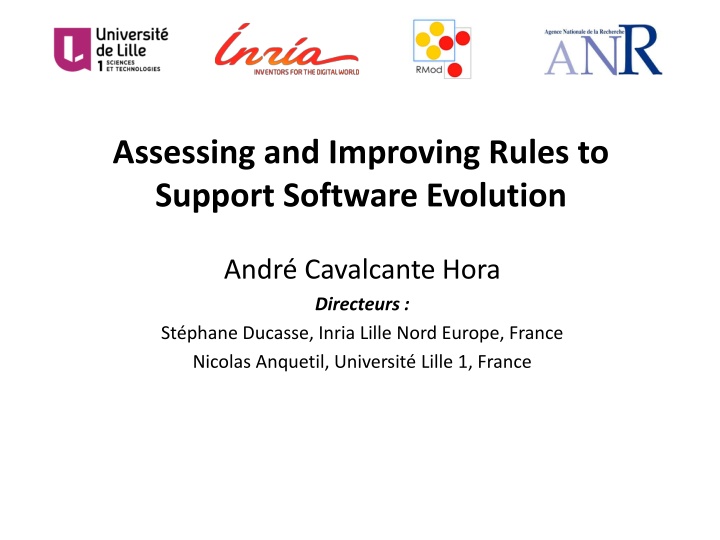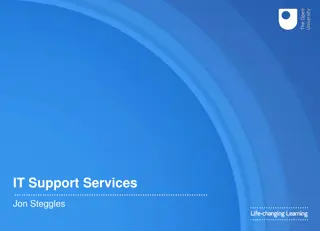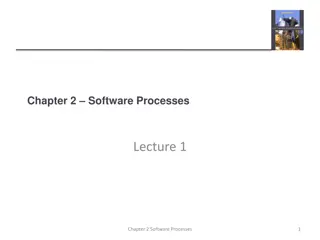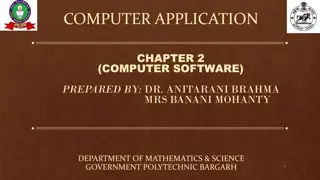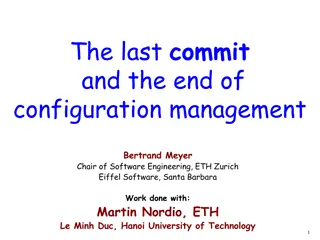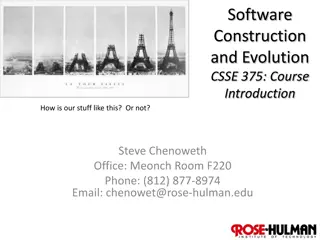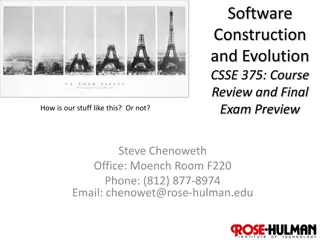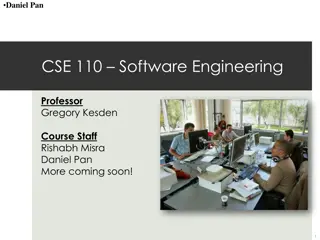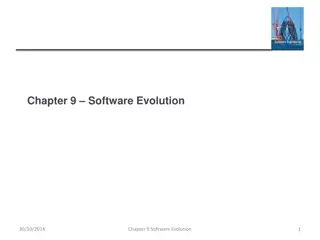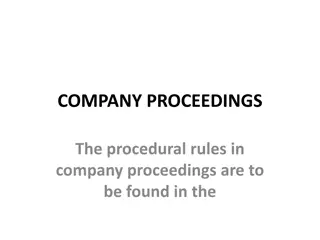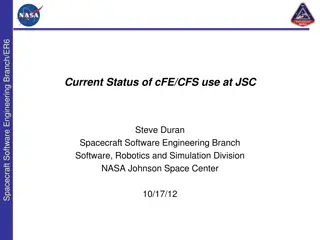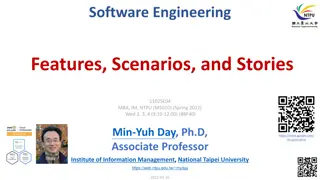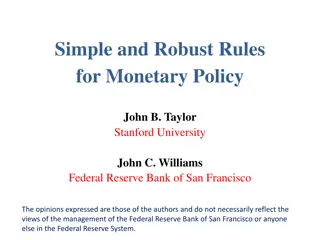Rules and Practices for Software Evolution Support
This content focuses on the importance of rules and practices to support software evolution, addressing challenges, benefits, and impact on ecosystems. It emphasizes the need for system-specific rules, automatic extraction of conventions, and client support. The evolution of software is highlighted as a complex task, requiring the maintenance of best practices for consistency and backward compatibility. Various strategies are discussed to ensure software evolution and propagate changes effectively.
Download Presentation

Please find below an Image/Link to download the presentation.
The content on the website is provided AS IS for your information and personal use only. It may not be sold, licensed, or shared on other websites without obtaining consent from the author.If you encounter any issues during the download, it is possible that the publisher has removed the file from their server.
You are allowed to download the files provided on this website for personal or commercial use, subject to the condition that they are used lawfully. All files are the property of their respective owners.
The content on the website is provided AS IS for your information and personal use only. It may not be sold, licensed, or shared on other websites without obtaining consent from the author.
E N D
Presentation Transcript
Assessing and Improving Rules to Support Software Evolution Andr Cavalcante Hora Directeurs : St phane Ducasse, Inria Lille Nord Europe, France Nicolas Anquetil, Universit Lille 1, France
Outline 1. Context and Motivation 2. Problems 3. Benefits of System-specific Rules 4. Supporting System-specific Conventions with Automatic Extraction 5. Supporting Client Systems with Automatic Extraction 6. Impact of Software Evolution on Ecosystems 7. Conclusion 2
Software Evolution (1) In software development, change is the only constant New features, bug-fixes, source code refactoring Up to 80% of the development cost Part of software ecosystems 3
Software Evolution (2) In Eclipse, 42% of the methods in version 1.0 were not in 2.0 [MWZ11] Clients are clearly impacted In Pharo, API evolution affected thousands of clients [RLR12] A minority of these clients were aware and reacted 4
Software Evolution (3) How can we ensure software evolution propagation? In summary: Software evolution is a complex task Aggravated in software ecosystems Developers need help to maintain their systems 5
Ensuring Software Evolution Good practices In practice Backward-compatibility [BTF05, DJ06, WGAK10] Deprecation with helpful messages [RLR12] Use of only public APIs [BR06,DR08,Bus13,BSvdB13] Software evolution is difficult! 6
Ensuring Consistency (1) Rules are used to ensure source code consistency Bug detection [LZ05, WH05, KPW06, NNP+10, SSPR12] Best coding practices and conventions [HP04, RBJ97, RDGN10] Class and method replacement [DR08, SJM08, WGAK10, MWZM12] 7
Ensuring Consistency (2) The literature provides two solutions to obtain these rules: 1. Manually created rules 2. Automatically created rules Normally validated in small-scale case studies There are lacks in each solution to support developers in their maintenance tasks effectively 8
Outline 1. Context and Motivation 2. Problems 3. Benefits of System-specific Rules 4. Supporting System-specific Conventions with Automatic Extraction 5. Supporting Client Systems with Automatic Extraction 6. Impact of Software Evolution on Ecosystems 7. Conclusion 9
Manually created rules (1) Generic rules Created by non-experts Valid for distinct systems Present in static analysis tools (FindBugs, PMD, SmallLint) SmallLint System-specific rules Created by experts on the system under analysis Focus on important problems Defined for each system Costly 10
Manually created rules (2) Goal: improve code quality Bug prevention: Generic rules: do not prevent bugs [WDA+08, BvdB06, CMSV12, BM08, BM09] System-specific rules: not yet investigated Problem 1: Due to their cost, are system-specific rules worthwhile? 11
Manual Automatic Apart from being costly: Experts may not have the complete knowledge Experts may no longer be available It is important to reduce the dependence on experts Second solution: automatically created rules 12
Automatically Created Rules Extracted from software repositories Inferred from systematic source code changes Two researches focus by existing studies: 1. System-specific analysis 2. Supporting API evolution 13
Automatically Created Rules (System-specific Analysis) Existing studies Bug-fix changes [KPW06, NNP+10] Rule-fix changes [KE07] Comparing the diff between two releases [MWZ11, LZ05] Bug-fix DB Rule-fix DB Systematic changes Systematic changes Bug-fix change Rule-fix change Revision 1 Release 1 Revision 2 Release 2 Revision n 14
Automatically Created Rules (System-specific Analysis) Source code usage conventions spread over time Apache Ant: InputStream.close() FileUtils.close(*) 6 years Rev 10 Rev 50 Rev 70 Rev 90 Rev n revisions Problem 2: System-specific conventions are not extracted from software repositories 15
Automatically Created Rules (Supporting API Evolution) Existing studies Evolution rules [DR08, SJM08, WGAK10, MWZM12] Mapping: 1-to-1, 1-to-n, m-to-1, m-to-n Type: replacement or suggestion Example: m1() m2() replacement suggestion m1() m2() m1() m2() m2() m1() m2() m1() m2() m1() Release 1 Release 2 revisions 16
Automatically Created Rules (Supporting API Evolution) Mapping 1-to-1 1-to-n, n-to-1, m-to-n Repl. Sugg. Repl. Sugg. [DR08] yes yes no no [SJM08] yes yes no no [WGAK10] yes no yes no [MWZM12] yes no yes no Problem 3: Not all mapping cases are covered 17
API Evolution Ecosystem Analysis Approaches to support API evolution are often evaluated in small-scale case studies As we explained before: A software system is often part of a bigger ecosystem 18
Software Ecosystem Analysis (1) Software ecosystems studies Social aspects [JSW11] Dependency between projects [LRL10, BCP+13] Visualization [LLGR10] Evolution size [GBRM+09] Natural ecosystems [MCG14, MCGS14, CMG14] 19
Software Ecosystem Analysis (2) Software ecosystem impact analysis: To better understand the real extension of the impact To understand how the impact can be alleviated Existing studies: API stability (Android ecosystem, 10 projects) [MRK13] API deprecation (Smalltalk ecosystem, 2,600 projects) [RLR12] Problem 4: The impact of API evolution on ecosystems is unknown 20
Problems and Contributions 1. Deep understanding of the benefits provided by system- specific rules We investigate whether such rules are worthwhile enforcing [HADA12] Improvement of automatically extracted rules to support system-specific conventions and API evolution We propose two solutions to extract better rules from software repositories [HADV13,HEA+14,HAE+14b,HAE+14a] Analysis of the impact of software evolution on clients We report on an investigation on the awareness of an ecosystem about software evolution [HRA+14] 2. 3. 21
Outline 1. Context and Motivation 2. Problems 3. Benefits of System-specific Rules 4. Supporting System-specific Conventions with Automatic Extraction 5. Supporting Client Systems with Automatic Extraction 6. Impact of Software Evolution on Ecosystems 7. Conclusion 22
Benefits of System-specific Rules (violations vs. bugs) Lines of code level Identifying lines with: Bugs Violations method v1 3. Mark bugs violation with bug without bug 1. Identify bug-fix commit TP with violation FP Fixed Issue #123 without violation FN TN method v2 violation violation + bug bug bug revisions 2. Calculate the diff 23
Experiment Results (RQ1) RQ1 Is there a relation between generic violations and bugs? H0 Generic violations and bugs are independent Ha Generic violation and bugs are related p-value = 0.65, precision = 5% with bug without bug total with violation 55 1,063 1,118 without violation 609 12,689 13,298 total 664 13,752 14,416 24
Experiment Results (RQ2) RQ2 Is there a relation between system-specific violations and bugs? H0System-specific violations and bugs are independent Ha System-specific violations and bugs are related p-value < 0.001, precision = 12% with bug without bug total with violation 37 275 312 without violation 627 13,477 14,104 total 664 13,752 14,416 25
Generic vs. Specific Rules: Summary (1) RQ1 Generic rules are not effective enough to be used for bug prevention Confirming existing studies RQ2 System-specific rules are more relevant to avoid bugs Effective to be used for bug prevention 26
Generic vs. Specific Rules: Summary (2) System-specific rules are worthwhile, but They are costly, created by experts Experts may not have the complete knowledge Experts may no longer be available Next: solutions to extract rules from software repositories, reducing the involvement of experts 27
Outline 1. Context and Motivation 2. Problems 3. Benefits of System-specific Rules 4. Supporting System-specific Conventions with Automatic Extraction 5. Supporting Client Systems with Automatic Extraction 6. Impact of Software Evolution on Ecosystems 7. Conclusion 28
Supporting System-specific Conventions with Automatically Created Rules Describing API change conventions as rules: Incremental revisions Predefined rule patterns that ensure their quality Occurrence over distinct revisions Rule category: recommendation Found in static analysis tools Support migration (PMD) Suggest the use of better APIs (FindBugs) Improve code legibility (SmallLint) Apache Ant: InputStream.close() FileUtils.close(*) SmallLint 29
Mining System-specific Rules (Overview) 1. Extracting deltas Rev 1 Rev 2 Rev 3 Rev n revisions deltas 2. Discovering rules Create rules (apply pattern) rules patterns candidate rules Filter rules 30
1. Extracting Deltas Format of the changes deleted-call(context-id, receiver, signature, static) deltas added-call(context-id, receiver, signature, static) Diff of method foo() between version 1 and 2 rpackage = RPackageOrganizer.default(); + rpackage = RPackage.organizer(); Formatted changes deleted-call( foo()-rev2 , RPackageOrganizer , default() , isStatic ) added-call( foo()-rev2 , RPackage , organizer() , isStatic ) 31
2. Discovering Rules (Creating Rules) Pattern 1: Change receiver and signature, static pattern1(deletedReceiver, deletedSignature, addedReceiver, addedSignature) = deleted-call(id, deletedReceiver, deletedSignature, isStatic ) and added-call(id, addedReceiver, addedSignature, isStatic ) Example 1: FileDirectory.default() FileSystem.workingDirectory() Pattern 2: Change signature, same receiver, non-static pattern2(deletedSignature, addedSignature) = deleted-call(id, receiver, deletedSignature, notStatic ) and added-call(id, receiver, addedSignature, notStatic ) Example 2: obj.noMoreNotificationsFor() obj.unsubscribe() 32
2. Discovering Rules (Filtering Rules) Assess the rules which are likely to be system- specific conventions We keep rules that occur over different revisions Rev 10 Rev 50 Rev 70 Rev 90 Rev n revisions 33
Experiment Setting (1) RQ1 Are the rules correct to the expert? With the help of an expert Rule correctness: correct or incorrect Delta database Versions Pharo 1.4 to 2.0 Timeframe April 2012 to March 2013 Revisions 435 #Extracted rules for pattern total 1 2 3 4 5 Candidates rules 25 31 49 304 17 426 Filtered rules ( 2 revisions) 14 11 3 13 4 45 34
Experiment Results (RQ1) RQ1 Are the rules correct to the expert? Pattern total 1 2 3 4 5 Filtered rules 14 11 3 13 4 45 Correct rules 11 (79%) 6 (55%) 1 (33%) 7 (54%) 3 (75%) 28 (62%) Example: RPackageOrganizer.default() RPackage.organizer() RPackageOrganizer.default() { "WARNING: Since this component can be changed (i.e. for testing), you should NOT use it directly. Use Rpackage.organizer() instead" . . . 35
System-specific conventions: Summary RQ1 62% (28 out of 45) of the rules were correct Java validation (Tomcat, Ant, Lucene): Two programming languages covered Lack as to better support client systems Next, supporting client developers 36
Outline 1. Context and Motivation 2. Problems 3. Benefits of System-specific Rules 4. Supporting System-specific Conventions with Automatic Extraction 5. Supporting Client Systems with Automatic Extraction 6. Impact of Software Evolution on Ecosystems 7. Conclusion 37
Supporting Client Systems with Automatically Created Rules Extracting API evolution rules: Incremental revisions Data-mining technique Formats: Mapping: 1-to-1, 1-to-n, n-to-1, m-to-n Type: replacement and suggestion 38
Mining API Change Rules (Overview) 1. Extracting deltas Rev 1 Rev 2 Rev 3 Rev n revisions deltas 2. Discovering rules Create rules (data mining) selected deltas rules Select deltas 39
1. Extracting Deltas from Revisions Format of the changes deleted-call(context-id, signature) deltas added-call(context-id, signature) Diff of method foo() between version 1 and 2 self.add(MooseModel.root().add(model)); + self.add(model.install()); Formatted changes deleted-call( foo()-rev2 , MooseModel.root() ) deleted-call( foo()-rev2 , MooseModel.add(MooseModel) ) added-call( foo()-rev2 , MooseModel.install() ) 40
2. Discovering Rules Request: Confidence = 75% foo() bar() Confidence = 25% n() 1st step: selecting deltas 2nd step: discovering rules deleted foo() a() bar() c() added d() e() f() a() d() foo() e() bar() k() foo() n() foo() bar() 41
Experiment Setting (1) Research questions RQ1 Are the generated rules valid to experts? RQ2 Which types of rules are generated? Experiment design (with the help of an expert) RQ1 Rule validity valid, invalid, or don t know RQ2 Rule types 1-to-1, 1-to-n, n-to-1, m-to-n replacement, suggestion 42
Experiment Setting (2) Context Real systems for which source code history is available Access to the experts of the systems Case studies Classes KLOC Contr. Revisions Deltas Experts Pharo2 3,246 374 37 435 3,196 2 Pharo3 3,844 412 37 483 4,729 4 Moose 2,617 210 21 512 2,848 4 Glamour 1,117 81 24 598 1,807 1 Roassal 411 29 6 379 1,559 1 Seaside 1,122 97 18 862 3,962 - 43
Experiment Results (RQ1) RQ1 Are the generated rules valid to experts? Rules Valid Invalid Don t know Precision Pharo2 62 17 20 25 46% Pharo3 95 68 24 3 74% Moose 50 43 7 0 86% Glamour 23 15 8 0 65% Roassal 36 28 8 0 78% Seaside 76 61 15 - 80% 44
Experiment Results (RQ2) RQ2 Which types of rules are generated? 1-to-1 1-to-m, m-to-1, m-to-n Rules replacement suggestion replacement suggestion Pharo2 42 16 (38%) 17 (40%) 8 (19%) 1 (2%) Pharo3 71 26 (37%) 23 (32%) 19 (27%) 3 (4%) Moose 61 15 (25%) 41 (67%) 2 (3%) 3 (5%) Glamour 43 14 (33%) 27 (63%) 2 (5%) 0 (0%) Roassal 15 7 (47%) 7 (47%) 1 (7%) 0 (0%) Seaside 28 2 (7%) 23 (82%) 3 (11%) 0 (0%) Total 260 80 (31%) 138 (53%) 35 (13%) 7 (3%) 45
Examples 1. isNil().ifTrue(*) ifNil(*) 1. Scanner.new().scanTokens(*) parseAsLiteralToken() 1. intersect(*) intersectIfNone(*,*) 1. Character.cr() ROPlatform.current().newLine() 46
Discovering API evolution rules: Summary RQ1 Precision remained between 46% and 86% RQ2 Rules 1-to-1, 1-to-n, n-to-1 and m-to-n involving method replacement and suggestion Also validated in C# case studies (Siemens) Single systems analysis Next, software ecosystem analysis 47
Outline 1. Context and Motivation 2. Problems 3. Benefits of System-specific Rules 4. Supporting System-specific Conventions with Automatic Extraction 5. Supporting Client Systems with Automatic Extraction 6. Impact of Software Evolution on Ecosystems 7. Conclusion 48
Impact of Software Evolution on Ecosystems (1) The analysis of software evolution on ecosystems help developers: To better understand the real extension of the impact To understand how the impact can be alleviated 49
Impact of Software Evolution on Ecosystems (2) Researchers should also support developers working in software ecosystems A first large-scale study [RLR12] API deprecation Naturally, API evolution is not restricted to deprecation 50
